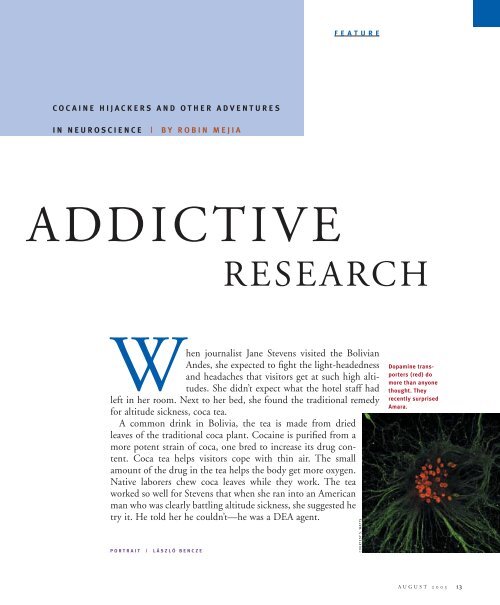Download - Pitt Med - University of Pittsburgh
Download - Pitt Med - University of Pittsburgh
Download - Pitt Med - University of Pittsburgh
Create successful ePaper yourself
Turn your PDF publications into a flip-book with our unique Google optimized e-Paper software.
FEATURE<br />
COCAINE HIJACKERS AND OTHER ADVENTURES<br />
IN NEUROSCIENCE | BY ROBIN MEJIA<br />
ADDICTIVE<br />
RESEARCH<br />
When journalist Jane Stevens visited the Bolivian<br />
Andes, she expected to fight the light-headedness<br />
and headaches that visitors get at such high altitudes.<br />
She didn’t expect what the hotel staff had<br />
left in her room. Next to her bed, she found the traditional remedy<br />
for altitude sickness, coca tea.<br />
A common drink in Bolivia, the tea is made from dried<br />
leaves <strong>of</strong> the traditional coca plant. Cocaine is purified from a<br />
more potent strain <strong>of</strong> coca, one bred to increase its drug content.<br />
Coca tea helps visitors cope with thin air. The small<br />
amount <strong>of</strong> the drug in the tea helps the body get more oxygen.<br />
Native laborers chew coca leaves while they work. The tea<br />
worked so well for Stevens that when she ran into an American<br />
man who was clearly battling altitude sickness, she suggested he<br />
try it. He told her he couldn’t—he was a DEA agent.<br />
PORTRAIT | LÁSZLÓ BENCZE<br />
COURTESY S. WATTS<br />
Dopamine transporters<br />
(red) do<br />
more than anyone<br />
thought. They<br />
recently surprised<br />
Amara.<br />
A UGUST 2003 13





![entire issue [pdf 2.79 mb] - Pitt Med - University of Pittsburgh](https://img.yumpu.com/50435398/1/190x231/entire-issue-pdf-279-mb-pitt-med-university-of-pittsburgh.jpg?quality=85)
![entire issue [pdf 6.47 mb] - Pitt Med - University of Pittsburgh](https://img.yumpu.com/50360689/1/190x231/entire-issue-pdf-647-mb-pitt-med-university-of-pittsburgh.jpg?quality=85)
![entire issue [pdf 12.7 mb] - Pitt Med - University of Pittsburgh](https://img.yumpu.com/49831615/1/190x231/entire-issue-pdf-127-mb-pitt-med-university-of-pittsburgh.jpg?quality=85)








![entire issue [pdf 11.3 mb] - Pitt Med - University of Pittsburgh](https://img.yumpu.com/46685830/1/190x231/entire-issue-pdf-113-mb-pitt-med-university-of-pittsburgh.jpg?quality=85)
![entire issue [pdf 12.7 mb] - Pitt Med - University of Pittsburgh](https://img.yumpu.com/44997419/1/190x231/entire-issue-pdf-127-mb-pitt-med-university-of-pittsburgh.jpg?quality=85)